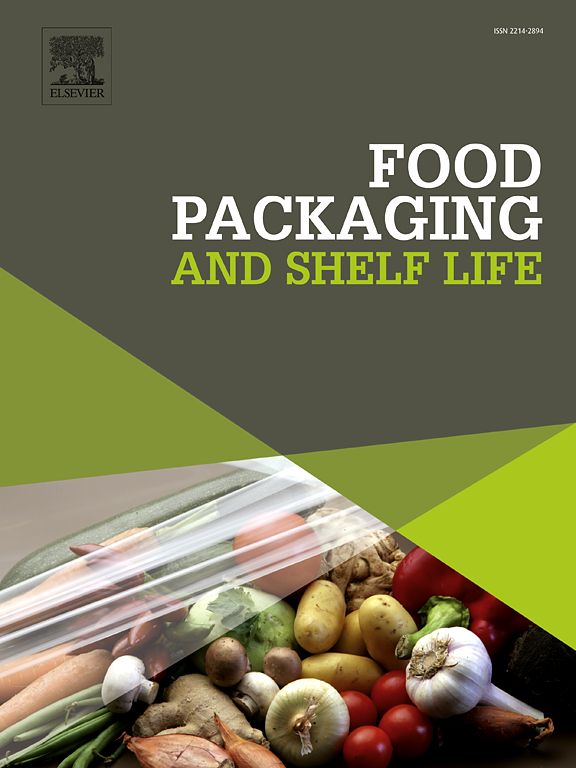含纳米银的蛋白质纳米纤维用于活性食品包装
IF 10.6
1区 农林科学
Q1 FOOD SCIENCE & TECHNOLOGY
引用次数: 0
摘要
不可生物降解塑料造成的日益严重的环境危机,以及对延长保质期和防止物理损害和食源性疾病的需求,凸显了对创新食品包装材料的迫切需求。基于纳米技术的干预措施解决了这些相互交织的挑战,通过使用嵌入金属纳米颗粒的可食用生物聚合物基质开发多功能薄膜。本研究提出了一种有效的方法,通过在静电纺丝前将不同浓度的LSNP直接混合到蛋白质溶液中,生产由葡萄糖交联的载溶菌酶银纳米颗粒(LSNP)的明胶-玉米蛋白纳米纤维。FESEM结果显示,加入2 mg/mL LSNP的纳米纤维(NF2)平均直径最小,为235.47 ± 73.13 nm。edx元素映射和TEM分析表明,LSNP在纳米纤维内均匀分散,证实了静电纺丝过程中有效的掺入。FTIR和XPS分析表明LSNP与明胶/玉米蛋白基质存在分子间相互作用。XRD分析证实了LSNP在纳米纤维中保存的结晶性质。有趣的是,NF2表现出增强的力学性能,抗拉强度(TS)为8.66 MPa,断裂伸长率(EAB)为114.9 %,杨氏模量(YM)为920 MPa。NF2的水接触角(WCA)最高,为144.49˚,具有良好的疏水性。此外,该膜具有良好的耐溶剂性,抗氧化活性为78.3% %,对各种食品相关病原体具有较强的抗菌作用。纳米材料在10天的土壤埋藏环境中表现出优异的生物降解性。同时,用NF2包装的水果在25℃下可保持10天的新鲜度。这些结果强调了负载lsnp的蛋白质纳米纤维作为活性食品包装应用的优越替代品的潜力。本文章由计算机程序翻译,如有差异,请以英文原文为准。
Proteinaceous nanofibers loaded with nano-silver for active food packaging applications
The increasing environmental crisis from non-biodegradable plastics, alongside the need for extended shelf life and protection against physical damage and foodborne diseases, underscores the urgent demand for innovative food packaging materials. Nanotechnology-based interventions address these intertwined challenges by developing multifunctional films using edible biopolymer matrices embedded with metal nanoparticles. This study presents an efficient approach to producing lysozyme silver nanoparticles (LSNP)-loaded gelatin-zein nanofibers, crosslinked by glucose, via direct blending of varying LSNP concentrations into the proteinaceous solution before electrospinning. FESEM findings revealed that incorporating 2 mg/mL LSNP into nanofibers (NF2) produced the smallest average diameter of 235.47 ± 73.13 nm. EDX-elemental mapping and TEM analysis demonstrated uniform LSNP dispersion within nanofibers, confirming the effective incorporation during electrospinning. FTIR and XPS analysis suggested intermolecular interaction between LSNP and gelatin/zein matrix. XRD analysis confirmed the preserved crystalline nature of LSNP within the nanofibers. Interestingly, NF2 exhibited enhanced mechanical properties with a tensile strength (TS) of 8.66 MPa, an elongation at break (EAB) of 114.9 %, and Young's modulus (YM) of 920 MPa. Moreover, NF2 showed the highest water contact angle (WCA) of 144.49˚, indicating excellent hydrophobicity. Additionally, the film demonstrated great solvent resistance, antioxidant activity of 78.3 %, and strong antibacterial efficiency against various bacterial strains of food-related pathogens. The nanomats exhibited exceptional biodegradability within a 10-day soil burial environment. Concurrently, fruits packaged in NF2 maintained freshness for up to 10 days at 25 ℃. These results accentuate the promising potential of LSNP-loaded proteinaceous nanofibers as a superior alternative for active food packaging applications.
求助全文
通过发布文献求助,成功后即可免费获取论文全文。
去求助
来源期刊

Food Packaging and Shelf Life
Agricultural and Biological Sciences-Food Science
CiteScore
14.00
自引率
8.80%
发文量
214
审稿时长
70 days
期刊介绍:
Food packaging is crucial for preserving food integrity throughout the distribution chain. It safeguards against contamination by physical, chemical, and biological agents, ensuring the safety and quality of processed foods. The evolution of novel food packaging, including modified atmosphere and active packaging, has extended shelf life, enhancing convenience for consumers. Shelf life, the duration a perishable item remains suitable for sale, use, or consumption, is intricately linked with food packaging, emphasizing its role in maintaining product quality and safety.
 求助内容:
求助内容: 应助结果提醒方式:
应助结果提醒方式:


